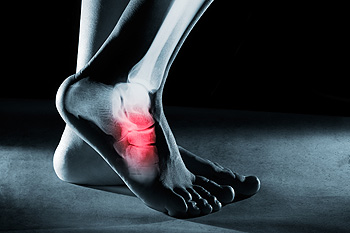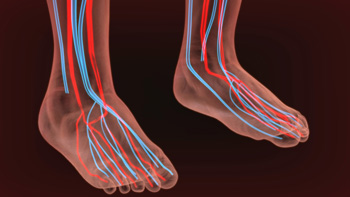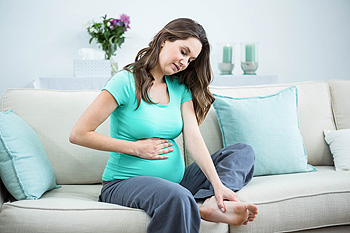Connect With Us
Blog
Items filtered by date: February 2019
Spotting Cuboid Syndrome
 Cuboid syndrome is caused by partial dislocation of bones in the middle of the foot. Someone with cuboid syndrome usually feels pain around the middle of the foot or at the base of their toes. There are some symptoms of this condition that, when coupled together, can help to identify cuboid syndrome. Pain on the lateral side of the foot or the side of the little toe is an initial indicator. Pain also tends to worsen when weight is placed on the foot, so activities like walking or jumping may trigger discomfort. It is also possible for the foot to swell and for there to be a reduced range of motion in the foot or ankle. If you suffer from any of these symptoms and think you might have cuboid syndrome, it is highly recommended that you speak with a podiatrist to begin treatment.
Cuboid syndrome is caused by partial dislocation of bones in the middle of the foot. Someone with cuboid syndrome usually feels pain around the middle of the foot or at the base of their toes. There are some symptoms of this condition that, when coupled together, can help to identify cuboid syndrome. Pain on the lateral side of the foot or the side of the little toe is an initial indicator. Pain also tends to worsen when weight is placed on the foot, so activities like walking or jumping may trigger discomfort. It is also possible for the foot to swell and for there to be a reduced range of motion in the foot or ankle. If you suffer from any of these symptoms and think you might have cuboid syndrome, it is highly recommended that you speak with a podiatrist to begin treatment.
Cuboid syndrome, also known as cuboid subluxation, occurs when the joints and ligaments near the cuboid bone in the foot become torn. If you have cuboid syndrome, consult with Tanisha Richmond, DPM from Richmond Foot & Ankle, LLC. Our doctor will assess your condition and provide you with quality foot and ankle treatment.
Cuboid syndrome is a common cause of lateral foot pain, which is pain on the outside of the foot. The condition may happen suddenly due to an ankle sprain, or it may develop slowly overtime from repetitive tension through the bone and surrounding structures.
Causes
The most common causes of cuboid syndrome include:
- Injury – The most common cause of this ailment is an ankle sprain.
- Repetitive Strain – Tension placed through the peroneus longus muscle from repetitive activities such as jumping and running may cause excessive traction on the bone causing it to sublux.
- Altered Foot Biomechanics – Most people suffering from cuboid subluxation have flat feet.
Symptoms
A common symptom of cuboid syndrome is pain along the outside of the foot which can be felt in the ankle and toes. This pain may create walking difficulties and may cause those with the condition to walk with a limp.
Diagnosis
Diagnosis of cuboid syndrome is often difficult, and it is often misdiagnosed. X-rays, MRIs and CT scans often fail to properly show the cuboid subluxation. Although there isn’t a specific test used to diagnose cuboid syndrome, your podiatrist will usually check if pain is felt while pressing firmly on the cuboid bone of your foot.
Treatment
Just as the range of causes varies widely, so do treatments. Some more common treatments are ice therapy, rest, exercise, taping, and orthotics.
If you have any questions, please feel free to contact our office located in Dayton, OH . We offer the newest diagnostic and treatment technologies for all your foot care needs.
Do Your Child's Feet Hurt?
Causes of Poor Circulation
 The medical condition that is referred to as poor circulation can be an indication of health issues that may exist in the body. It may be caused by poor dietary habits or sitting for extended periods of time. Additional causes may consist of diabetes, peripheral artery disease (PAD), or blood clots in the legs. Many patients experience symptoms that are indicative of poor circulation, and these may include a lack of energy, feet that are cold the majority of the time, or a tingling or numbing sensation in the hands and feet. Other symptoms may consist of having a poor memory, a weakened immune system, or a loss of appetite. Research has indicated that maintaining a healthy diet and engaging in an exercise regime may be helpful in treating poor circulation. It’s important to drink plenty of fresh water daily, in addition to avoiding alcohol. If poor circulation is affecting your feet, it is suggested to speak to a podiatrist who can properly diagnose and treat this condition.
The medical condition that is referred to as poor circulation can be an indication of health issues that may exist in the body. It may be caused by poor dietary habits or sitting for extended periods of time. Additional causes may consist of diabetes, peripheral artery disease (PAD), or blood clots in the legs. Many patients experience symptoms that are indicative of poor circulation, and these may include a lack of energy, feet that are cold the majority of the time, or a tingling or numbing sensation in the hands and feet. Other symptoms may consist of having a poor memory, a weakened immune system, or a loss of appetite. Research has indicated that maintaining a healthy diet and engaging in an exercise regime may be helpful in treating poor circulation. It’s important to drink plenty of fresh water daily, in addition to avoiding alcohol. If poor circulation is affecting your feet, it is suggested to speak to a podiatrist who can properly diagnose and treat this condition.
Poor circulation is a serious condition and needs immediate medical attention. If you have any concerns with poor circulation in your feet contact Tanisha Richmond, DPM of Richmond Foot & Ankle, LLC. Our doctor will treat your foot and ankle needs.
Poor Circulation in the Feet
Poor blood circulation in the feet and legs is can be caused by peripheral artery disease (PAD), which is the result of a buildup of plaque in the arteries.
Plaque buildup or atherosclerosis results from excess calcium and cholesterol in the bloodstream. This can restrict the amount of blood which can flow through the arteries. Poor blood circulation in the feet and legs are sometimes caused by inflammation in the blood vessels, known as vasculitis.
Causes
Lack of oxygen and oxygen from poor blood circulation restricts muscle growth and development. It can also cause:
- Muscle pain, stiffness, or weakness
- Numbness or cramping in the legs
- Skin discoloration
- Slower nail & hair growth
- Erectile dysfunction
Those who have diabetes or smoke are at greatest risk for poor circulation, as are those who are over 50. If you have poor circulation in the feet and legs it may be caused by PAD and is important to make changes to your lifestyle in order to reduce risk of getting a heart attack or stroke. Exercise and maintaining a healthy lifestyle will dramatically improve conditions.
As always, see a podiatrist as he or she will assist in finding a regimen that suits you. A podiatrist can also prescribe you any needed medication.
If you have any questions please feel free to contact our office located in Dayton, OH . We offer the newest diagnostic and treatment technologies for all your foot and ankle needs.
Swollen Feet and Pregnancy
 A typical symptom that many pregnant women may notice is swollen feet. This may generally occur during the second and third trimester, and can be uncomfortable. This may be a result of a thickened blood flow, in addition to the growing fetus, uterus, and placenta. There may be several reasons why discomfort may be experienced, including standing or sitting for extended periods of time, exposure to heat during the summer months, improper sodium intake, or carrying more than one baby. Moderate relief may be found by elevating the feet frequently during the day, limiting caffeine and sodium intake, wearing comfortable shoes, and drinking plenty of fresh water daily. If the feet should suddenly appear swollen, it may be indicative of medical conditions that may be present. If you feel any pain in your feet, it is suggested to speak to a podiatrist who can properly determine the cause.
A typical symptom that many pregnant women may notice is swollen feet. This may generally occur during the second and third trimester, and can be uncomfortable. This may be a result of a thickened blood flow, in addition to the growing fetus, uterus, and placenta. There may be several reasons why discomfort may be experienced, including standing or sitting for extended periods of time, exposure to heat during the summer months, improper sodium intake, or carrying more than one baby. Moderate relief may be found by elevating the feet frequently during the day, limiting caffeine and sodium intake, wearing comfortable shoes, and drinking plenty of fresh water daily. If the feet should suddenly appear swollen, it may be indicative of medical conditions that may be present. If you feel any pain in your feet, it is suggested to speak to a podiatrist who can properly determine the cause.
Pregnant women with swollen feet can be treated with a variety of different methods that are readily available. For more information about other cures for swollen feet during pregnancy, consult with Tanisha Richmond, DPM from Richmond Foot & Ankle, LLC. Our doctor will attend to all of your foot and ankle needs.
What Foot Problems Can Arise During Pregnancy?
One problem that can occur is overpronation, which occurs when the arch of the foot flattens and tends to roll inward. This can cause pain and discomfort in your heels while you’re walking or even just standing up, trying to support your baby.
Another problem is edema, or swelling in the extremities. This often affects the feet during pregnancy but tends to occur in the later stages.
How Can I Keep My Feet Healthy During Pregnancy?
- Wearing orthotics can provide extra support for the feet and help distribute weight evenly
- Minimize the amount of time spent walking barefoot
- Wear shoes with good arch support
- Wear shoes that allow for good circulation to the feet
- Elevate feet if you experience swelling
- Massage your feet
- Get regular, light exercise, such as walking, to promote blood circulation to the feet
If you have any questions please feel free to contact our office located in Dayton, OH . We offer the newest diagnostic and treatment technologies for all your foot and ankle needs.
Blog Archives
- March 2025
- February 2025
- January 2025
- December 2024
- November 2024
- October 2024
- September 2024
- August 2024
- July 2024
- June 2024
- May 2024
- April 2024
- March 2024
- February 2024
- January 2024
- December 2023
- November 2023
- October 2023
- September 2023
- August 2023
- July 2023
- June 2023
- May 2023
- April 2023
- March 2023
- February 2023
- January 2023
- December 2022
- November 2022
- October 2022
- September 2022
- August 2022
- July 2022
- June 2022
- May 2022
- April 2022
- March 2022
- February 2022
- January 2022
- December 2021
- November 2021
- October 2021
- September 2021
- August 2021
- July 2021
- June 2021
- May 2021
- April 2021
- March 2021
- February 2021
- January 2021
- December 2020
- November 2020
- October 2020
- September 2020
- August 2020
- July 2020
- June 2020
- May 2020
- April 2020
- March 2020
- February 2020
- January 2020
- December 2019
- November 2019
- October 2019
- September 2019
- August 2019
- July 2019
- June 2019
- May 2019
- April 2019
- March 2019
- February 2019
- January 2019
- December 2018
- November 2018

